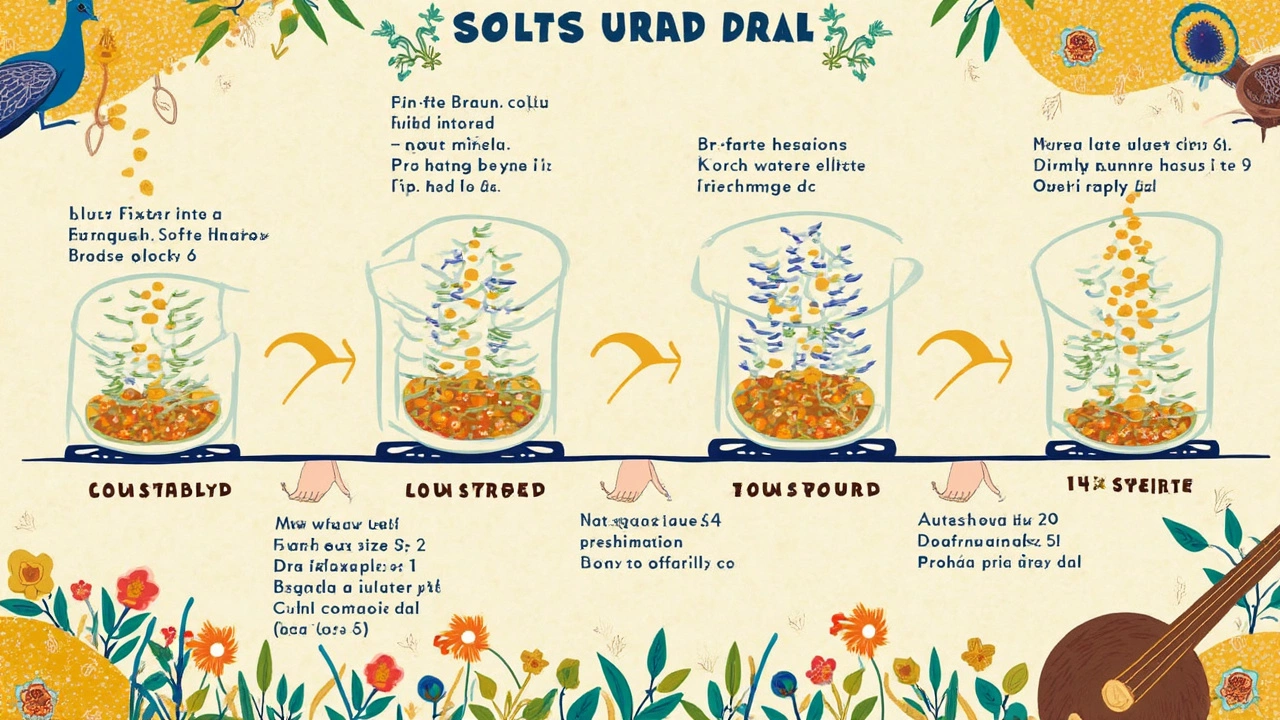How Much Time Do We Actually Need to Soak Urad Dal for Vada?

Ever tried making vadas and ended up with rock-hard ones or a mushy mess? Believe it or not, the soaking time for urad dal might be the culprit. If you’re new to this, here’s a tip: soaking isn’t just about getting the dal wet. It's crucial for that perfect texture and taste.
Let’s dig into why soaking urad dal is more important than you’d think. First off, the soak softens the dal, which transforms into a fluffy batter. This process usually takes about 4 to 6 hours—pretty much the sweet spot to get them airy inside and crisp outside. Too little soaking, and you’re risking under-hydrated dal. Go too long, and you might notice the batter getting overly fermented, giving off a strong, tangy taste. Nobody wants that when aiming for deliciously subtle vadas!
Why Soak Urad Dal?
Soaking urad dal isn’t just about getting them wet; it's science at play. The soaking process initiates enzyme activity, which helps break down anti-nutrients like phytic acid. This makes the dal more digestible, which is a win for your tummy.
More than just digestibility, soaking time is the magic behind that airy, slightly crispy vada texture. When you soak, the dal absorbs water, expanding and softening—which is key. Once you grind it, the batter should hold air, thanks to those softened grains. That’s why a good soak is a no-brainer if you’re after the fluffiest vadas.
Soaking also enhances fermentation. A naturally fermented batter makes tastier dishes. It might sound a bit fancy, but it's all about letting helpful bacteria do their work—the kind that develops flavor complexity while also making nutrients more available.
Don’t forget consistency. A well-hydrated dal doesn't just grind better; it mixes evenly with other ingredients. This ensures every bite of your vada from top to bottom is uniform in taste and texture. And trust me, you don't want to bite into a surprise cluster of unsoaked dal in your vada recipe!
| Factor | Benefit |
|---|---|
| Enzyme Activity | Improves digestion |
| Water Absorption | Softens dal, ensuring fluffy texture |
| Fermentation | Enhances flavor; makes nutrients more available |
Perfect Soaking Duration
Getting the urad dal soaking time just right is kind of like finding the sweet spot in a good cake recipe. Too short, and your batter lacks the fluffiness. Too long, and you’ll end up with a funky-tasting mixture. So, what's the magic number? Generally, a solid 4 to 6 hours does the trick for most kitchens.
Find Your Soak Spot
Influencing factors like room temperature and the quality of your dal can tweak this timeline. Merely soaking for 4 hours at a warmer room temperature can work wonders. But cooler spots in colder climates might stretch that bracket a bit closer to 6 hours.
Benefits of Timing It Right
- Better Texture: Well-soaked dal becomes plump and ready to break down into the smoothest batter, ideal for forming airy vadas.
- Fermentation Control: Extended soaking can kick-start fermentation. While some tanginess is pleasant, overdoing it can make the vadas sour.
- Saves Time: Prepping ingredients like dal ahead means less waiting around on cooking day.
If you're juggling life’s busy schedule and often forget, set a timer or alarm. The right timing can turn this simple step into a game-changer for that vada recipe you’ve been perfecting!

Tips for Best Results
Getting the perfect vada isn't just about the soaking time; there are a few handy tips that can make a huge difference. For starters, always use fresh urad dal. Aged dal might not fluff up as well, leaving you with flat and dense vadas.
One secret tip is to add fenugreek seeds while soaking. It not only helps in fermentation but also gives the vadas a lovely golden color. Speaking of fermentation, keep an eye on the weather. Warm temperatures can speed up the fermentation process, which is something to keep in mind if you live in a hot climate.
Use the Right Temperature
Grind the soaked dal with cold water. This method helps in maintaining the temperature, ensuring the batter doesn't heat up, which can affect its texture. If the batter feels warm after grinding, chill it in the fridge for a bit.
Gauge the Thickness
A thick, creamy batter is our goal. If you can scoop it with your hand and the batter holds its shape, you've nailed it. Don't forget to add a pinch of salt while grinding—not only for taste but to help the batter whip better.
Quote from Chef Sanjeev Kapoor
"The key to perfect vadas is all in the consistency of the batter. It should not be too watery or too thick. Aim for the right balance and you're halfway there!"
For all you numbers folks out there, here's a quick tip: Use about 1.5 cups of water for every cup of urad dal while grinding. Adjust as you go because some will require more or less water.
Once you're ready to fry, wet your palms every time you scoop the batter. This simple hack prevents sticking and makes it easier to shape your vadas.
- Ensure your oil is hot enough. A small dollop of batter should sizzle and rise steadily to the surface.
- Turn the vadas carefully, using a slotted spoon to keep them intact.
- Drain excess oil on a paper towel before serving to keep them crisp.
By following these tips and using quality urad dal, you'll be serving up perfect vadas, with that ideal balance of crispy outside and fluffy inside.
Common Mistakes to Avoid
Making urad dal soaking time errors can mess up the perfect vada prep. There are a few pitfalls that are way too easy to slip into, but don't worry—it's just as easy to dodge them once you know what to watch out for.
Soaking Too Short Or Too Long
One of the top mistakes is not soaking for the right amount of time. If you soak urad dal for vada less than 4 hours, it might remain too hard, leading to a batter that's difficult to grind smoothly. On the flip side, soaked beyond 8 hours, it can get overly fermented, causing an unwanted tangy flavor.
Using Too Much Water
When soaking, you need enough water to cover the dal, but not drown it. Too much water can dilute the dal's nuttiness and even affect the moisture during grinding, making the batter runny.
Skipping the Rinse
Rinsing the dal before soaking isn't just about cleanliness; it removes excess starch that can affect the batter’s right consistency. Remember to give it a few rinses till the water runs clear.
Not Draining Properly
After the soak, proper draining is key. Excess water mixing with your batter can lead to heavy, greasy vadas. A good practice is to let the dal sit in a sieve for a few minutes after draining to ensure no extra water sneaks in.
Ignoring Soak Temperature
A fun fact: soaking in warm water can cut down your urad dal soaking time by an hour or so. But always ensure the temperature isn’t too hot, or you’ll hasten fermentation. Aim for lukewarm, room-temperature water for the best results.